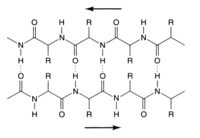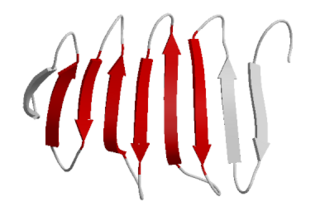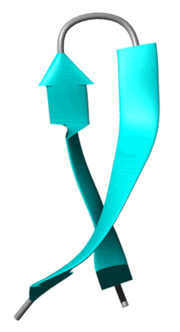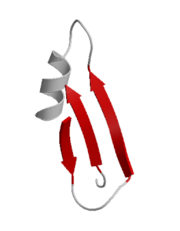Beta sheet

The β sheet (also β-pleated sheet) is the second form of regular secondary structure in proteins consisting of beta strands connected laterally by three or more hydrogen bonds, forming a generally twisted, pleated sheet (the most common form of regular secondary structure in proteins is the alpha helix). A beta strand (also β-strand) is a stretch of amino acids typically 5–10 amino acids long whose peptide backbones are almost fully extended. The association of beta sheets has been implicated in the formation of protein aggregates and fibrils observed in many human diseases, notably the amyloidoses.
Contents |
Nomenclature
In the most common usage, β strand refers to a single continuous stretch of amino acids adopting an extended conformation and involved in hydrogen bonds; by contrast, a β sheet refers to an assembly of such strands that are hydrogen-bonded to each other.
History
The first β sheet structure was proposed by William Astbury in the 1930s. He proposed the idea of hydrogen bonding between the peptide bonds of parallel or antiparallel extended β strands. However, Astbury did not have the necessary data on the bond geometry of the amino acids in order to build accurate models, especially since he did not then know that the peptide bond was planar. A refined version was proposed by Linus Pauling and Robert Corey in 1951.
Structure and orientation

Illustration of the hydrogen bonding patterns, represented by dotted lines, in an antiparallel beta sheet. Oxygen atoms are colored red and nitrogen atoms colored blue.
|

Illustration of the hydrogen bonding patterns, represented by dotted lines, in a parallel beta sheet. Oxygen atoms are colored red and nitrogen atoms colored blue.
|
Geometry
The majority of β strands are arranged adjacent to other strands and form an extensive hydrogen bond network with their neighbors in which the N-H groups in the backbone of one strand establish hydrogen bonds with the C=O groups in the backbone of the adjacent strands. In the fully extended β strand, successive side chains point straight up, then straight down, then straight up, etc. Adjacent β strands in a β sheet are aligned so that their Cα atoms are adjacent and their side chains point in the same direction. The "pleated" appearance of β strands arises from tetrahedral chemical bonding at the Cα atom; for example, if a side chain points straight up, then the bond to the  must point slightly downwards, since its bond angle is approximately 109.5°. The pleating causes the distance between
must point slightly downwards, since its bond angle is approximately 109.5°. The pleating causes the distance between  and
and  to be approximately 6 Å, rather than the 7.6 Å (2 × 3.8 Å) expected from two fully extended trans peptide virtual bonds. The "sideways" distance between adjacent Cα atoms in hydrogen-bonded β strands is roughly 5 Å.
to be approximately 6 Å, rather than the 7.6 Å (2 × 3.8 Å) expected from two fully extended trans peptide virtual bonds. The "sideways" distance between adjacent Cα atoms in hydrogen-bonded β strands is roughly 5 Å.
However, β strands are rarely perfectly extended; rather, they exhibit a slight twist due to the chirality of their component amino acids. The energetically preferred dihedral angles (φ, ψ) = (–135°, 135°) (broadly, the upper left region of the Ramachandran plot) diverge somewhat from the fully extended conformation (φ, ψ) = (–180°, 180°).[1] The twist is often associated with alternating fluctuations in the dihedral angles to prevent the individual β strands in a larger sheet from splaying apart. A good example of such a twisted β-hairpin can be seen in the protein BPTI.
The side chains point outwards from the folds of the pleats, roughly perpendicularly to the plane of the sheet; successive residues point outwards on alternating faces of the sheet.
Hydrogen bonding patterns
Because peptide chains have a directionality conferred by their N-terminus and C-terminus, β strands too can be said to be directional. They are usually represented in protein topology diagrams by an arrow pointing toward the C-terminus. Adjacent β strands can form hydrogen bonds in antiparallel, parallel, or mixed arrangements.
In an antiparallel arrangement, the successive β strands alternate directions so that the N-terminus of one strand is adjacent to the C-terminus of the next. This is the arrangement that produces the strongest inter-strand stability because it allows the inter-strand hydrogen bonds between carbonyls and amines to be planar, which is their preferred orientation. The peptide backbone dihedral angles (φ, ψ) are about (–140°, 135°) in antiparallel sheets. In this case, if two atoms  and
and  are adjacent in two hydrogen-bonded β strands, then they form two mutual backbone hydrogen bonds to each other's flanking peptide groups; this is known as a close pair of hydrogen bonds.
are adjacent in two hydrogen-bonded β strands, then they form two mutual backbone hydrogen bonds to each other's flanking peptide groups; this is known as a close pair of hydrogen bonds.
In a parallel arrangement, all of the N-termini of successive strands are oriented in the same direction; this orientation is slightly less stable because it introduces nonplanarity in the inter-strand hydrogen bonding pattern. The dihedral angles (φ, ψ) are about (–120°, 115°) in parallel sheets. It is rare to find less than five interacting parallel strands in a motif, suggesting that a smaller number of strands may be unstable. In this case, if two atoms  and
and  are adjacent in two hydrogen-bonded β strands, then they do not hydrogen bond to each other; rather, one residue forms hydrogen bonds to the residues that flank the other (but not vice versa). For example, residue
are adjacent in two hydrogen-bonded β strands, then they do not hydrogen bond to each other; rather, one residue forms hydrogen bonds to the residues that flank the other (but not vice versa). For example, residue  may form hydrogen bonds to residues
may form hydrogen bonds to residues  and
and  ; this is known as a wide pair of hydrogen bonds. By contrast, residue
; this is known as a wide pair of hydrogen bonds. By contrast, residue  may hydrogen-bond to different residues altogether, or to none at all.
may hydrogen-bond to different residues altogether, or to none at all.
Finally, an individual strand may exhibit a mixed bonding pattern, with a parallel strand on one side and an antiparallel strand on the other. Such arrangements are less common than a random distribution of orientations would suggest, indicating that this pattern is less stable than the antiparallel arrangement.
The hydrogen bonding of β strands need not be perfect, but can exhibit localized disruptions known as beta bulges.
The hydrogen bonds lie roughly in the plane of the sheet, with the peptide carbonyl groups pointing in alternating directions with successive residues; for comparison, successive carbonyls point in the same direction in the alpha helix.
Amino acid propensities
Large aromatic residues (Tyr, Phe and Trp) and β-branched amino acids (Thr, Val, Ile) are favored to be found in β strands in the middle of β sheets. Interestingly, different types of residues (such as Pro) are likely to be found in the edge strands in β sheets, presumably to avoid the "edge-to-edge" association between proteins that might lead to aggregation and amyloid formation.
Common structural motifs

Portion of outer surface Protein A of Borrelia burgdorferi complexed with a murine monoclonal antibody.

A very simple structural motif involving β sheets is the β hairpin, in which two antiparallel strands are linked by a short loop of two to five residues, of which one is frequently a glycine or a proline, both of which can assume the unusual dihedral-angle conformations required for a tight turn. However, individual strands can also be linked in more elaborate ways with long loops that may contain alpha helices or even entire protein domains.
Greek key motif
The Greek key motif consists of four adjacent antiparallel strands and their linking loops. It consists of three antiparallel strands connected by hairpins, while the fourth is adjacent to the first and linked to the third by a longer loop. This type of structure forms easily during the protein folding process. It was named after a pattern common to Greek ornamental artwork.
The β-α-β motif
Due to the chirality of their component amino acids, all strands exhibit a "right-handed" twist evident in most higher-order β sheet structures. In particular, the linking loop between two parallel strands almost always has a right-handed crossover chirality, which is strongly favored by the inherent twist of the sheet. This linking loop frequently contains a helical region, in which case it is called a β-α-β motif. A closely related motif called a β-α-β-α motif forms the basic component of the most common protein tertiary structure, the TIM barrel.

Portion of Carboxypeptidase A.
β-meander motif
A simple supersecondary protein topology composed of 2 or more consecutive antiparallel β-strands linked together by hairpin loops[2][3]. This motif is common in β-sheets and can be found in several structural architectures including β-barrels and β-propellers.
Psi-loop motif
The psi-loop, Ψ-loop, motif consists of two antiparallel strands with one strand in between that is connected to both by hydrogen bonds.[4] There are four possible strand topologies for single Ψ-loops as cited by Hutchinson et al. 1990. This motif is rare as the process resulting in its formation seems unlikely to occur during protein folding. The Ψ-loop was first identified in the aspartic protease family.[5]
Structural architectures of proteins with beta-sheets
Beta-sheets are present in all-β, α+β and α/β domains according to Structural Classification of Proteins and in many peptides or small proteins with poorly defined overall architecture. All-β domains may form β barrels, β sandwiches, β prisms, β propellers, and β-helices.
Structural topology
The topology of a β sheet describes the order of hydrogen-bonded β strands along the backbone. For example, the flavodoxin fold has a five-stranded, parallel β sheet with topology 21345; thus, the edge strands are β strand 2 and β strand 5 along the backbone. Spelled out explicitly, β strand 2 is H-bonded to β strand 1, which is H-bonded to β strand 3, which is H-bonded to β strand 4, which is H-bonded to β strand 5, the other edge strand. In the same system, the Greek key motif described above has a 4123 topology. The secondary structure of a β sheet can be described roughly by giving the number of strands, their topology, and whether their hydrogen bonds are parallel or antiparallel.
β sheets can be open, meaning that they have two edge strands (as in the flavodoxin fold or the immunoglobulin fold)) or they can be closed beta barrels (such as the TIM barrel). β-Barrels are often described by their stagger or shear. Some open β sheets are very curved and fold over on themselves (as in the SH3 domain) or form horseshoe shapes (as in the ribonuclease inhibitor). Open β sheets can assemble face-to-face (such as the beta-propeller domain or immunoglobulin fold) or edge-to-edge, forming one big β sheet.
Parallel β helices
A β helix is formed from repeating structural units consisting of two or three short β strands linked by short loops. These units "stack" atop one another in a helical fashion so that successive repetitions of the same strand hydrogen-bond with each other in a parallel orientation. In β helices, the strands themselves are nearly planar; the resulting helical surfaces are nearly flat, forming a triangular prism shape.
The two-strand helix is found in the enzyme pectate lyase. Its two loops are each six residues long and bind stabilizing calcium ions to maintain the integrity of the structure. The more complex three-strand helix contains three linking loops, of which one is consistently two residues long and the others are variable. This structure is found in bacteriophage P22 tailspike protein.[6]
β sheets in pathology
Some proteins that are disordered or helical as monomers, such as amyloid β (see amyloid plaque) can form β-sheet-rich oligomeric structures associated with pathological states. The amyloid β protein's oligomeric form is implicated as a cause of Alzheimer's. Its structure has yet to be determined in full, but recent data suggests that it may resemble an unusual two-strand β helix.[7]
The side chains from the amino acid residues found in a β sheet structure may also be arranged such that many of the adjacent sidechains on one side of the sheet are hydrophobic, while many of those adjacent to each other on the alternate side of the sheet are polar or charged (hydrophilic), which can be useful if the sheet is to form a boundary between polar/watery and nonpolar/greasy environments.
References
- ↑ Voet D, Voet JG. (2004). Biochemistry Vol 1 3rd ed. Wiley. See esp. pp 227–231.
- ↑ SCOP: Fold: WW domain-like
- ↑ PPS '96 - Super Secondary Structure
- ↑ Hutchinson E. & Thornton J. 1996, "Promotif-A program to identify and analyze structural motifs in proteins", Protein Science, vol. 5, pp. 212-220.
- ↑ Hutchinson E. & Thornton J. 1990, "HERA-A program to draw schematic diagrams of protein secondary structures", Proteins: Structure, Function, and Genetics, vol. 8, pp. 203-212.
- ↑ Carl Branden and John Tooze. 1999. Introduction to Protein Structure 2nd ed. Garland Publishing: New York, NY. See esp. pp 20-32 and ch. 5.
- ↑ Nelson R, Sawaya MR, Balbirnie M, Madsen AO, Riekel C, Grothe R, Eisenberg D. 2005. Structure of the cross-beta spine of amyloid-like fibrils. Nature 435: 773-8.
- Cooper, J. "Super Secondary Structure - Part II", May 31,1996. Accessed May 25,2007.
- Structural Classification of Proteins (SCOP) "Open-sided Beta-meander", October 20, 2006. Accessed May 31, 2007.
See also
- Folding (chemistry)
- Tertiary structure
- α helix
- Collagen helix
- Foldamers
External links
- Interactive model of an anti-parallel β sheet (plug-in required)
- Interactive model of a parallel β sheet (plug-in required)
- Animated details of β-pleated sheet
| Protein secondary structure | ||
|---|---|---|
| Helices: | α-helix | 310 helix | π-helix | β-helix | Polyproline helix | Collagen helix | |
| Extended: | β-strand | Turn | Beta hairpin | Beta bulge | α-strand | |
| Supersecondary: | Coiled coil | Helix-turn-helix | EF hand | |
| Secondary structure propensities of amino acids | ||
| Helix-favoring: | Methionine | Alanine | Leucine | Glutamic acid | Glutamine | Lysine | |
| Extended-favoring: | Threonine | Isoleucine | Valine | Phenylalanine | Tyrosine | Tryptophan | |
| Disorder-favoring: | Glycine | Serine | Proline | Asparagine | Aspartic acid | |
| No preference: | Cysteine | Histidine | Arginine | |
| ←Primary structure | Tertiary structure→ | |